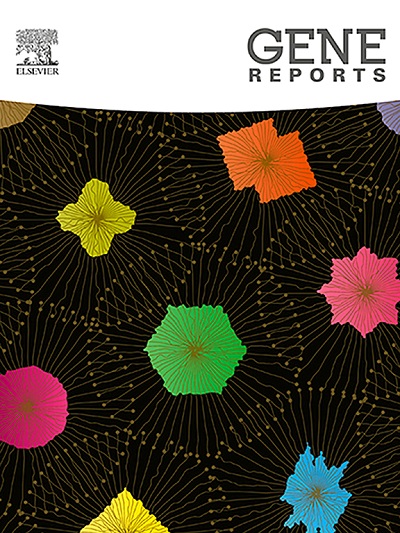幽门螺杆菌以外的尿素酶阳性细菌的耐药性和胃炎患者尿素酶基因的分布情况
IF 1
Q4 GENETICS & HEREDITY
引用次数: 0
摘要
幽门螺杆菌以外的尿素酶阳性细菌已被证明存在于口腔、胃、肠道、泌尿道和皮肤中。本研究旨在评估胃炎患者胃活检组织中非幽门螺杆菌尿素酶阳性细菌的流行率、分离菌的抗生素耐药性模式以及尿素A、尿素B和尿素C基因的流行率。在这项研究中,165 份活检样本取自消化内科医生转诊到医院的胃炎患者的胃窦。经过快速尿素酶测试后,样本使用脑心输液肉汤转移培养基转移到微生物实验室。然后,用标准微生物学方法鉴定非幽门螺杆菌。此外,幽门螺杆菌阳性样本还通过病理检测、粪便抗原检测试验和酶联吸附剂检测法进行了检测。不过,在微生物生长和纯化后,又进行了尿素酶测试。下一步是提取所有确诊分离物的 DNA,并使用特定引物通过 PCR 方法评估尿素酶 A、尿素酶 B 和尿素酶 C 基因的存在。在 100 份尿素酶阳性的活检样本中,77 份感染了幽门螺杆菌,23 份为非幽门螺杆菌阳性。表皮葡萄球菌是本研究中最常见的非幽门螺杆菌阳性细菌。细菌的抗生素耐药性模式显示,四环素和红霉素分别是对革兰氏阳性和阴性细菌最无效的抗生素。不过,革兰氏阳性菌对联合三唑的耐药率最低,而头孢他啶、氯霉素和头孢曲松则是对革兰氏阴性菌最有效的抗生素。此外,在 21.73% 的非幽门螺杆菌分离物中检测到了 ureA 基因,而 ureB 和 ureC 阳性的分离物分别占 8.69% 和 43.47%。这项研究表明,非幽门螺杆菌尿素酶阳性细菌导致胃炎的意义重大。看来,对这些细菌的诊断可以有效地治疗胃炎患者。此外,在这些分离菌中,ureC 基因是产生尿素酶的主要基因。本文章由计算机程序翻译,如有差异,请以英文原文为准。
Drug resistance of urease-positive bacteria other than Helicobacter pylori and distribution of urease genes in patients with gastritis
Urease-positive bacteria other than Helicobacter pylori have been shown to be present in the mouth, stomach, intestines, urinary tract, and skin. The aim of this study was to evaluate the prevalence of non-H. pylori urease-positive bacteria in the gastric biopsies of patients with gastritis and the antibiotic resistance pattern of the isolates, along with the prevalence of ureA, ureB, and ureC genes. In this study, 165 biopsies were collected from the gastric antrum of patients with gastritis referred to hospitals by a gastroenterologist. After Rapid Urease Test, the samples were transferred to the microbiology laboratory using a Brain Heart Infusion broth transfer medium. Next, the non-H. pylori bacteria were identified by the standard microbiological methods. Also, the H. pylori-positive samples were detected using the pathological testing, stool antigen detection test, and enzyme linked sorbent assay. However, after the growth and purification of microorganisms, the urease test was carried out again. In the next step, the DNAs of all confirmed isolates were extracted and the presence of ureA, ureB, and ureC genes was evaluated using the specific primers by the PCR method. Among the 100 urease-positive biopsies, 77 samples were infected with H. pylori and 23 were non-H. pylori-positive. Staphylococcus epidermidis was the most prevalent non-H. pylori-positive bacteria in this study. The antibiotic resistance pattern of the bacteria showed that tetracycline and erythromycin were the least effective antibiotics against the gram-positive and -negative, respectively. However, the lowest resistance rate of gram-positive bacteria was detected against co-trimoxazole, while cefotaxime, chloramphenicol, and ceftriaxone were the most effective antibiotics against the gram-negative bacteria. In addition, the ureA gene was detected among 21.73 % of the non-H. pylori isolates, while 8.69 % and 43.47 % of them were ureB and ureC positive, respectively. This study showed a considerable significance of non-H. pylori urease-positive bacteria causing gastritis. It seems that the diagnosis of these organisms can be effective in treatment of patients with gastritis. Also, the ureC gene was predominant to produce the urease in these isolates.
求助全文
通过发布文献求助,成功后即可免费获取论文全文。
去求助
来源期刊

Gene Reports
Biochemistry, Genetics and Molecular Biology-Genetics
CiteScore
3.30
自引率
7.70%
发文量
246
审稿时长
49 days
期刊介绍:
Gene Reports publishes papers that focus on the regulation, expression, function and evolution of genes in all biological contexts, including all prokaryotic and eukaryotic organisms, as well as viruses. Gene Reports strives to be a very diverse journal and topics in all fields will be considered for publication. Although not limited to the following, some general topics include: DNA Organization, Replication & Evolution -Focus on genomic DNA (chromosomal organization, comparative genomics, DNA replication, DNA repair, mobile DNA, mitochondrial DNA, chloroplast DNA). Expression & Function - Focus on functional RNAs (microRNAs, tRNAs, rRNAs, mRNA splicing, alternative polyadenylation) Regulation - Focus on processes that mediate gene-read out (epigenetics, chromatin, histone code, transcription, translation, protein degradation). Cell Signaling - Focus on mechanisms that control information flow into the nucleus to control gene expression (kinase and phosphatase pathways controlled by extra-cellular ligands, Wnt, Notch, TGFbeta/BMPs, FGFs, IGFs etc.) Profiling of gene expression and genetic variation - Focus on high throughput approaches (e.g., DeepSeq, ChIP-Seq, Affymetrix microarrays, proteomics) that define gene regulatory circuitry, molecular pathways and protein/protein networks. Genetics - Focus on development in model organisms (e.g., mouse, frog, fruit fly, worm), human genetic variation, population genetics, as well as agricultural and veterinary genetics. Molecular Pathology & Regenerative Medicine - Focus on the deregulation of molecular processes in human diseases and mechanisms supporting regeneration of tissues through pluripotent or multipotent stem cells.
 求助内容:
求助内容: 应助结果提醒方式:
应助结果提醒方式:


